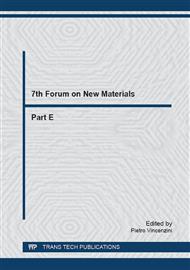[1]
G. Minati, The Meta-structures project, http: /arxiv. org/ftp/arxiv/papers/0903/0903. 0592. pdf.
Google Scholar
[2]
K.H. Matlack, A. Bauhofer, S. Krödel, A. Palermo, C. Daraio, Composite 3D printed metastructures for low frequency and broadband vibration absorption, arXiv: 1511. 09465 [cond-mat. mtrl-sci].
DOI: 10.1073/pnas.1600171113
Google Scholar
[3]
J. D. Hobeck, Ch. M.V. Laurent, D. J. Inman, 3D printing of metastructures for passive broadband vibration suppression, Proc. 20th International Conference on Composite Materials, Copenhagen, 19-24th July (2015).
Google Scholar
[4]
S. Krödel, N. Thoméa, C. Daraio, Wide band-gap seismic metastructures, Extreme Mechanics Letters, early view (2015).
DOI: 10.1016/j.eml.2015.05.004
Google Scholar
[5]
O, Hunaidi, Traffic Vibrations in Buildings, Construction Technology Updates, n. 39, NRC-CNRC (2000).
Google Scholar
[6]
L. Andersen, S.R.K. Nielsen, Reduction of ground vibration by means of barriers or soil improvement along a railway track, Soil Dynamics and Earthquake Engineering 25 (2005) 701–716.
DOI: 10.1016/j.soildyn.2005.04.007
Google Scholar
[7]
A. Talja, J. Törnqvist, Traffic-induced building vibration – A tool for planning of land use. Proceedings: SB10 Espoo: Sustainable Community - buildingSMART, held in September 2010, in Espoo, Finland (2010).
Google Scholar
[8]
http: /www. rivas-project. eu/index. php?id=8.
Google Scholar
[9]
E. Celebi, S. Fırat, G. Beyhan, I. Cankaya, I. Vural, O. Kırtel, Field experiments on wave propagation and vibration isolation by using wave barriers, Soil Dynamics and Earthquake Engineering 29 (2009) 824–833.
DOI: 10.1016/j.soildyn.2008.08.007
Google Scholar
[10]
A. Alzawi, M.H. ElNaggar, Full scale experimental study on vibration scattering using open and in-filled (GeoFoam) wave barriers, Soil Dynamics and Earthquake Engineering 31 (2011) 306–317.
DOI: 10.1016/j.soildyn.2010.08.010
Google Scholar
[11]
C. Murillo, L. Thorel, B. Caicedo, Ground vibration isolation with geofoam barriers: Centrifuge modeling, Geotextiles and Geomembranes 27 (2009) 423–434.
DOI: 10.1016/j.geotexmem.2009.03.006
Google Scholar
[12]
P. Cacciola, A. Tombari, Vibrating barrier: a novel device for the passive control of structures under ground motion. Proc. R. Soc. A 471: 20150075. (2015) http: /dx. doi. org/10. 1098/rspa. 2015. 0075.
DOI: 10.1098/rspa.2015.0075
Google Scholar
[13]
J: G Wang, W. Sun, S: Anand, Numerical investigation on active isolation of ground shock by soft porous layers, Journal of Sound and Vibration 321 (2009) 492–509.
DOI: 10.1016/j.jsv.2008.09.047
Google Scholar
[14]
S. Casciati, R.L. Borja, Dynamic FE analysis of south Memnon colossus including 3D soil-foundation-structure interaction, Computers and Structures, 82(20-21) (2004) 1719-1736.
DOI: 10.1016/j.compstruc.2004.02.026
Google Scholar
[15]
S. Casciati, L. Faravelli, Quantity vs. Quality in the Model Order Reduction (MOR) of a Linear System", Smart Structures and Systems, 13 (1) (2014) 99-109.
DOI: 10.12989/sss.2014.13.1.099
Google Scholar
[16]
C. Farhat, Ph. Avery, T. Chapman, J. Cortial, Dimensional reduction of nonlinear finite element dynamic models with finite rotations and energy-based mesh sampling and weighting for computational efficiency, International Journal for Numerical Methods in Engineering, 98 (9) (2014).
DOI: 10.1002/nme.4668
Google Scholar
[17]
C. Farhat, T. Chapman, Ph. Avery Ph., Structure-preserving, stability, and accuracy properties of the energy-conserving sampling and weighting method for the hyper reduction of nonlinear finite element dynamic models, International Journal for Numerical Methods in Engineering, 102 (5) (2015).
DOI: 10.1002/nme.4820
Google Scholar
[18]
F. Casciati, L. Faravelli, Dynamic Transient Analysis of Systems with Material Nonlinearity: a Model Order Reduction Approach, Smart Structures and Systems, 18, 1 (2016).
DOI: 10.12989/sss.2016.18.1.001
Google Scholar
[19]
http: /www. faa. gov/documentlibrary/media/advisory_circular/150-5390-2b/150_5390_2b. doc (2004).
Google Scholar
[20]
http: /fas. org/nuke/intro/aircraft/afman32-1123. pdf (1999).
Google Scholar
[21]
https: /www. wbdg. org/ccb/DOD/UFC/ufc_3_260_01. pdf (2008).
Google Scholar
[22]
http: /www. mscsoftware. com/it/product/marc (2004).
Google Scholar
[23]
http: /www. mathworks. com/index. html?s_tid=gn_loc_drop (2004).
Google Scholar


